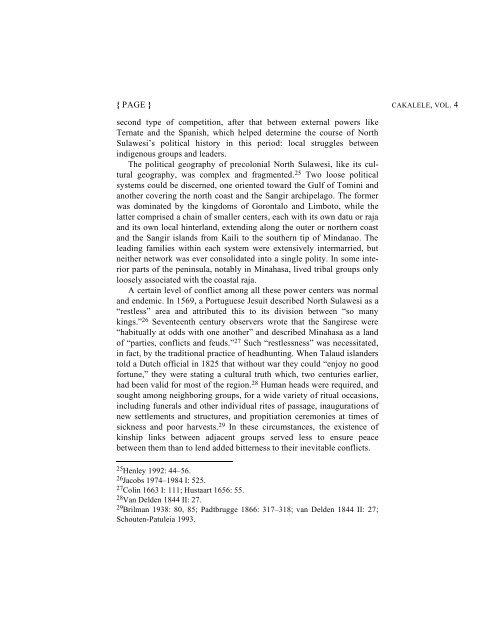a superabundance of centers: ternate and the contest for north ...
a superabundance of centers: ternate and the contest for north ...
a superabundance of centers: ternate and the contest for north ...
You also want an ePaper? Increase the reach of your titles
YUMPU automatically turns print PDFs into web optimized ePapers that Google loves.
{ PAGE } CAKALELE, VOL. 4<br />
second type <strong>of</strong> competition, after that between external powers like<br />
Ternate <strong>and</strong> <strong>the</strong> Spanish, which helped determine <strong>the</strong> course <strong>of</strong> North<br />
Sulawesi’s political history in this period: local struggles between<br />
indigenous groups <strong>and</strong> leaders.<br />
The political geography <strong>of</strong> precolonial North Sulawesi, like its cultural<br />
geography, was complex <strong>and</strong> fragmented. 25 Two loose political<br />
systems could be discerned, one oriented toward <strong>the</strong> Gulf <strong>of</strong> Tomini <strong>and</strong><br />
ano<strong>the</strong>r covering <strong>the</strong> <strong>north</strong> coast <strong>and</strong> <strong>the</strong> Sangir archipelago. The <strong>for</strong>mer<br />
was dominated by <strong>the</strong> kingdoms <strong>of</strong> Gorontalo <strong>and</strong> Limboto, while <strong>the</strong><br />
latter comprised a chain <strong>of</strong> smaller <strong>centers</strong>, each with its own datu or raja<br />
<strong>and</strong> its own local hinterl<strong>and</strong>, extending along <strong>the</strong> outer or nor<strong>the</strong>rn coast<br />
<strong>and</strong> <strong>the</strong> Sangir isl<strong>and</strong>s from Kaili to <strong>the</strong> sou<strong>the</strong>rn tip <strong>of</strong> Mindanao. The<br />
leading families within each system were extensively intermarried, but<br />
nei<strong>the</strong>r network was ever consolidated into a single polity. In some interior<br />
parts <strong>of</strong> <strong>the</strong> peninsula, notably in Minahasa, lived tribal groups only<br />
loosely associated with <strong>the</strong> coastal raja.<br />
A certain level <strong>of</strong> conflict among all <strong>the</strong>se power <strong>centers</strong> was normal<br />
<strong>and</strong> endemic. In 1569, a Portuguese Jesuit described North Sulawesi as a<br />
“restless” area <strong>and</strong> attributed this to its division between “so many<br />
kings.” 26 Seventeenth century observers wrote that <strong>the</strong> Sangirese were<br />
“habitually at odds with one ano<strong>the</strong>r” <strong>and</strong> described Minahasa as a l<strong>and</strong><br />
<strong>of</strong> “parties, conflicts <strong>and</strong> feuds.” 27 Such “restlessness” was necessitated,<br />
in fact, by <strong>the</strong> traditional practice <strong>of</strong> headhunting. When Talaud isl<strong>and</strong>ers<br />
told a Dutch <strong>of</strong>ficial in 1825 that without war <strong>the</strong>y could “enjoy no good<br />
<strong>for</strong>tune,” <strong>the</strong>y were stating a cultural truth which, two centuries earlier,<br />
had been valid <strong>for</strong> most <strong>of</strong> <strong>the</strong> region. 28 Human heads were required, <strong>and</strong><br />
sought among neighboring groups, <strong>for</strong> a wide variety <strong>of</strong> ritual occasions,<br />
including funerals <strong>and</strong> o<strong>the</strong>r individual rites <strong>of</strong> passage, inaugurations <strong>of</strong><br />
new settlements <strong>and</strong> structures, <strong>and</strong> propitiation ceremonies at times <strong>of</strong><br />
sickness <strong>and</strong> poor harvests. 29 In <strong>the</strong>se circumstances, <strong>the</strong> existence <strong>of</strong><br />
kinship links between adjacent groups served less to ensure peace<br />
between <strong>the</strong>m than to lend added bitterness to <strong>the</strong>ir inevitable conflicts.<br />
25Henley 1992: 44–56.<br />
26Jacobs 1974–1984 I: 525.<br />
27Colin 1663 I: 111; Hustaart 1656: 55.<br />
28Van Delden 1844 II: 27.<br />
29Brilman 1938: 80, 85; Padtbrugge 1866: 317–318; van Delden 1844 II: 27;<br />
Schouten-Patuleia 1993.
















